After a recent commissioned photo shoot with Kim McElroy from Broken Horn D Ranch, I asked Kim to share how and why they use horses on her Prescott Cattle Ranch. Enjoy this entertaining and insightful guest blog about cattle and horses.
Why do we use horses on the ranch?
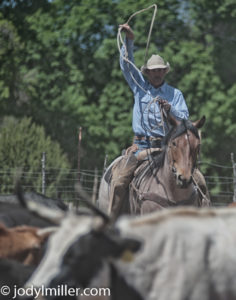 While at first glance this might seem a silly question, there are really a number of reasons we, and other ranchers, use horses on the ranch. In our case, the horses were here first. I trained horses professionally and my husband Dave team roped, so we usually had cattle around that were leased from a stock contractor. Occasionally, we would buy some cattle, use them for training the horses, and then sell them at the local auction barn. Dave bought two roping heifers once and when they were too big to rope, he turned them out with a friend’s bull and we were in the cow business! That first calf crop gave us another heifer, who is still in our cow herd today, and a steer that we sold. Another cow or two were purchased, along with a Corriente bull and the rest is history. We now run over 200 head of Corriente cattle. So using our horses to move, sort and work the cattle came naturally.
While at first glance this might seem a silly question, there are really a number of reasons we, and other ranchers, use horses on the ranch. In our case, the horses were here first. I trained horses professionally and my husband Dave team roped, so we usually had cattle around that were leased from a stock contractor. Occasionally, we would buy some cattle, use them for training the horses, and then sell them at the local auction barn. Dave bought two roping heifers once and when they were too big to rope, he turned them out with a friend’s bull and we were in the cow business! That first calf crop gave us another heifer, who is still in our cow herd today, and a steer that we sold. Another cow or two were purchased, along with a Corriente bull and the rest is history. We now run over 200 head of Corriente cattle. So using our horses to move, sort and work the cattle came naturally.
Cattle can be conditioned to tolerate just about any method of gentle handling,
whether horseback, on foot, with dogs or using quads. The big outfits in Australia use dirtbikes. Horses are the traditional choice for many reasons. First, and probably most important, they are a fellow herd and prey animal, so the cattle will adapt to their presence easily. Second, horses are much quieter than any mechanized vehicle, allowing a person to prowl around a rugged or brushy pasture hunting for the cattle without scaring them off. Horses have a wonderful ability to see or hear the cattle way before their rider does, so the astute cowboy pays attention to his horse’s gaze and the turn of his ear. Sitting atop a horse also gives the cowboy a slightly better vantage point for seeing the cattle in the aforementioned pasture conditions. The horse is also a great companion and doesn’t run out of gas when you are a long way from the house!
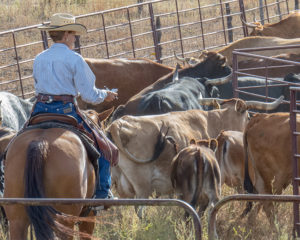
Kim checking the tags for sorting
Once the cattle have been located, the next task is often to drive or move them to a set of pens where perhaps the calves will be branded or weaned. In this case, the quickness and agility of the horse makes keeping the cattle bunched and moving in the right direction much easier. When cattle are really trying you and not wanting to go where you want, or the terrain is rough, maneuvering a quad or dirt bike is almost impossible. Once, we had to pen some cattle on the ranch headquarter, which is only 140 acres. Dave was already horseback and thought he could get it done by himself. The cows were giving him a hard time so he hollered for me to come help. Rather than take the time to catch &saddle a horse, I jumped on the quad. Things were going well until one cow broke ranks and I sped around to cut her off, as I got her back to the herd I suddenly realized I was headed straight for a 3 foot drop-off! No time to turn or to stop, I just did an Evil Kenivel jump off the embankment and rattled a few of my teeth on the landing!
Horses are the tool of choice when sorting cattle for sure.
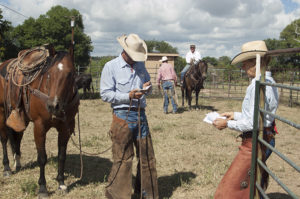
Kim and Dave comparing notes
Sorting can involve separating cows from calves, wets from drys, sorting the bulls off, sorting off a sick one for doctoring, sorting the ones you will keep as replacement heifers and the list goes on. Good cow horses have innate cow sense, the ability to “read” what a cow is going to do and instinctively react to it. The cowboy will quietly enter the herd of cattle and with catlike stalking, smoothly maneuver the cow of choice out of the bunch and past the herdholders. Modern day cutting horse competitions arose out of just such daily ranch work.
Another time when we are grateful for our horses is at spring branding, when the calves are branded, ear tagged with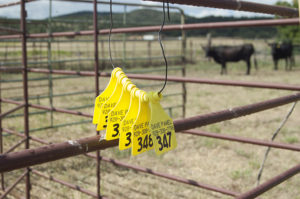 a numbered tag and vaccinated. Some operations use a chute system or a calf table, where the calf can be restrained for the process. We feel we are able to process our calves faster, with the animal on the ground for a shorter time and therefore under less stress, when we rope the calves. The cowboy mounted on his horse slips through the herd of cattle, waiting for a shot at the hind feet of a calf. Patiently swinging his rope, he watches for an opportunity to deliver the loop in between the front and back legs of the calf and come up with the two hind feet in the loop.
a numbered tag and vaccinated. Some operations use a chute system or a calf table, where the calf can be restrained for the process. We feel we are able to process our calves faster, with the animal on the ground for a shorter time and therefore under less stress, when we rope the calves. The cowboy mounted on his horse slips through the herd of cattle, waiting for a shot at the hind feet of a calf. Patiently swinging his rope, he watches for an opportunity to deliver the loop in between the front and back legs of the calf and come up with the two hind feet in the loop.
He holds the slack of the rope until it comes tight, then takes a dally around his saddle horn, before gently pulling the calf toward the waiting branding crew. The team of flankers works in ballet- like timing, with one man pulling the rope in an upward swooping motion while the other man pulls the calf’s tail toward the ground. This smoothly lays the calf on its side. Then one man places a knee on the calf’s neck while the other sits down behind the calf and uses his foot to push against the calf’s hock while he holds the other hind leg. Simultaneously, the ground crew sweeps in to give the shots, tag the ear and brand the left hip. This all takes place in just 20 seconds and the calf is let back up to rejoin the herd.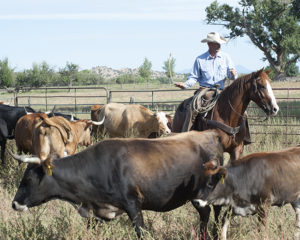
There are 7 or 8 pastures in operation at any given time, each housing a set of cows, their bull and in the spring and summer months, the calves, too. Some of the pastures are only 400 acres or so, others close to 1,000. The terrain is highly varied from grassy meadows to mountainous, rocky and rough with deep canyons, to creek bottoms with quicksand and very tall cattails! Every few days we ride through each of our cow herds to check on the condition and health of the cattle and the forage, document the birthdate, sex & color of the calves and to keep the cattle gentle and used to seeing and hearing us. This is probably the ranch chore we enjoy the most, prowling around God’s beautiful creation, enjoying the beauty of the landscape, the wildlife and the cattle, all while partnered with one of the most spectacular animals ever created – the horse.
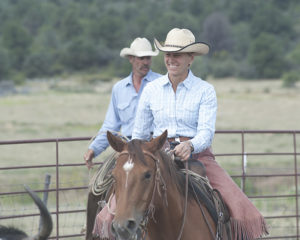
Kim McElroy Broken Horn D Ranch Prescott, AZ 928-708-9385
Jody Miller is a professional photographer specializing in Horse Photography, Equine Photography, and Equestrian photography. Jody is available for commissioned photo shoots. Her work can be viewed online here in her gallery section, and she is also featured at Arts Prescott Gallery, in Arizona.
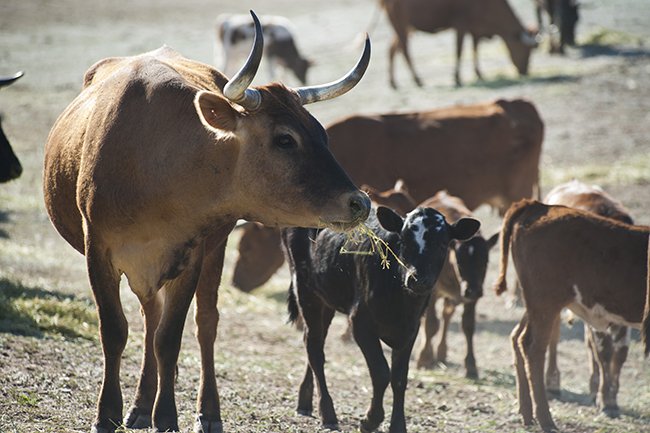
Comments
Jody you do an awesome job in the what you capture with your photography. I enjoy seeing the day to day life of the cowboy and ranchers. Something that is slowly fading away in our society. Thanks for the glimpse.
Thanks Sue. If’s so much fun!